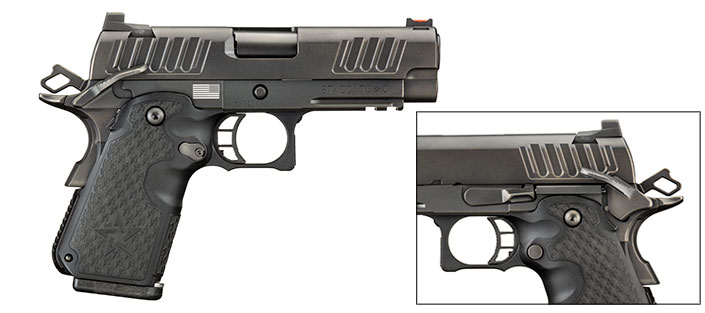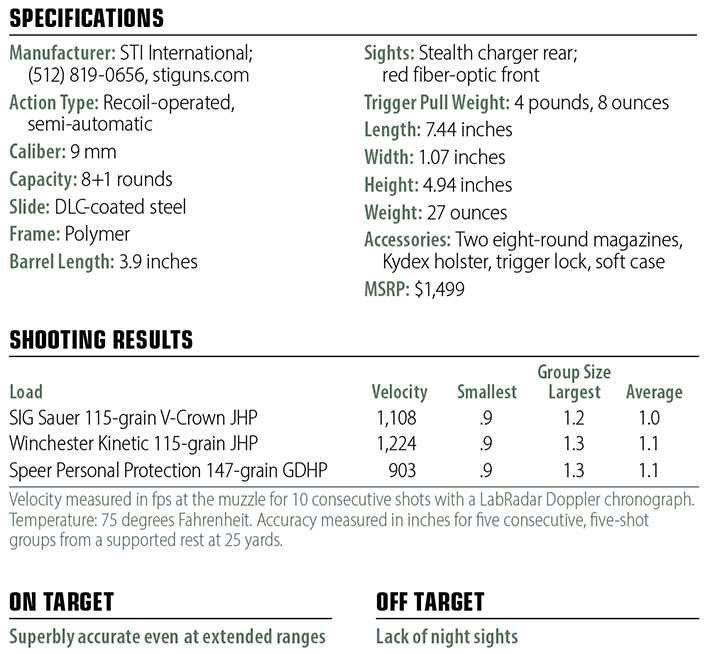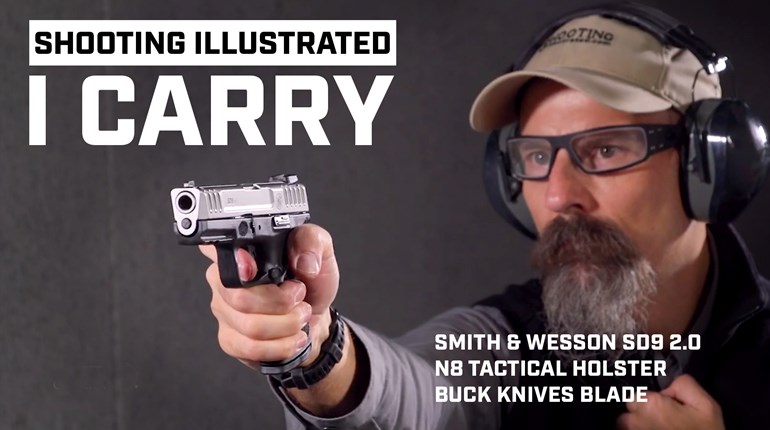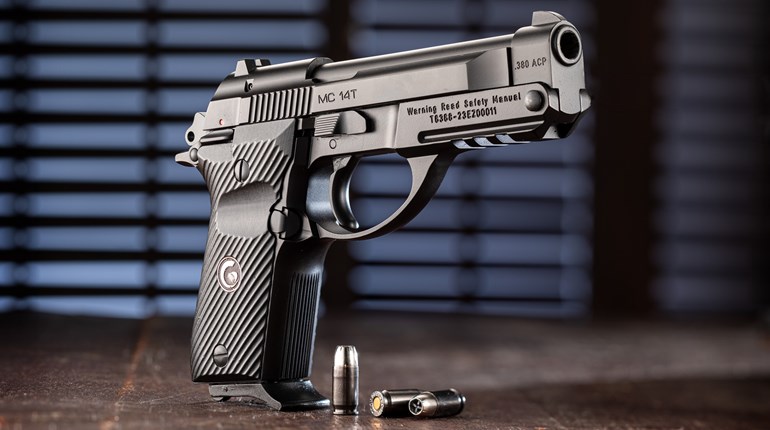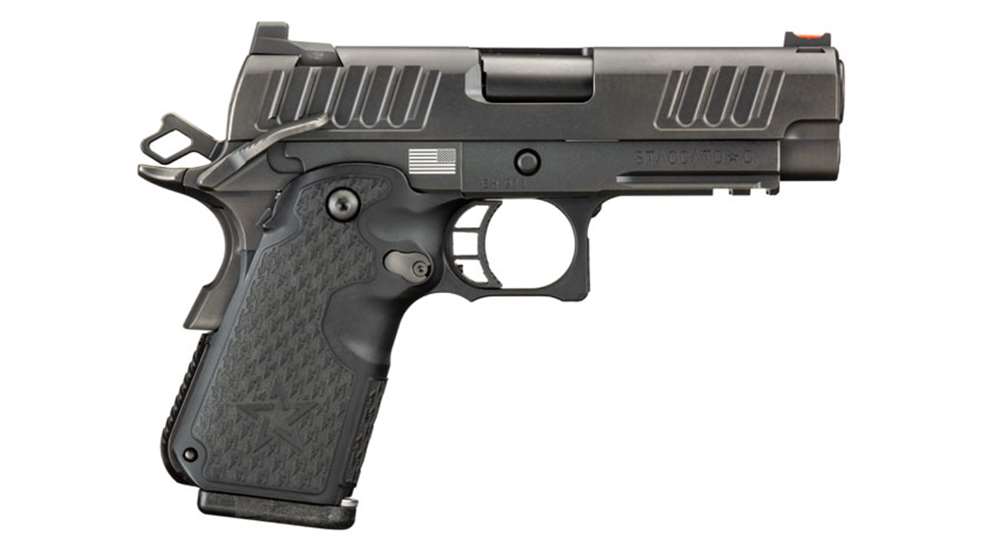
Everyone who knows anything about 1911-type pistols and competition knows STI International. It makes high-capacity handguns for action-shooting events, right? Well, the company also makes flat, compact, everyday carry (EDC) pistols as well. Case in point: the Staccato-C, a compact, single-stack 1911-type pistol chambered in 9 mm.
The slide-and-barrel fit is a bushingless design with a captured recoil-spring system, a design a lot more common in the 21st century than it had been earlier. This provides a dual-spring recoil system in the space available and consistently locks the barrel to the slide without the extra complexity that a bushing brings to the equation. Bushings in compact 1911s can be a real headache, and STI avoids that by using a bull-barrel design.
There are cocking serrations fore and aft; large, shallow grooves with the edges “melted” so they won’t shred your holster, hands or clothing. The ejection port is lowered and scalloped at the rear, to allow complete and consistent ejection of your brass, without mangling it in the process. The extractor is the correct internal Browning design, and should you ever have a problem with it, the woods are full of pistolsmiths capable of fitting and tuning a replacement. Sights on the Staccato are a fiber-optic front and a ledged rear, designed for one-handed slide activation should the emergency arise. This does require a bit of training and practice, so if you plan to have this option available to you, train for it.
Inside the slide, the STI barrel is slightly less than 4 inches long and features an integral feedramp. This gives the cartridge tip a smooth, continuous surface to travel along and also provides support for the rear of the case. Since you will likely be using a JHP bullet, feeding is important. Defensive ammunition typically pushes the pressure limits of the 9 mm specifications, even if it isn’t a +P, and this pistol can handle +P ammo.
The frame on the Staccato-P is steel, although if you want to shave a few more ounces off the weight of your Staccato, an aluminum frame is also available. The end of which sports an accessory rail underneath. The Staccato-C is built with the dustcover short of the slide end, and the slide and recoil spring tunnel are sculpted like the original 1911s, just shorter. (Its sibling, the Staccato-P, sports a dustcover the full length of the slide, and the slide is not sculpted, which creates a blunter muzzle end contour. I prefer the C, as it makes re-holstering easier.)
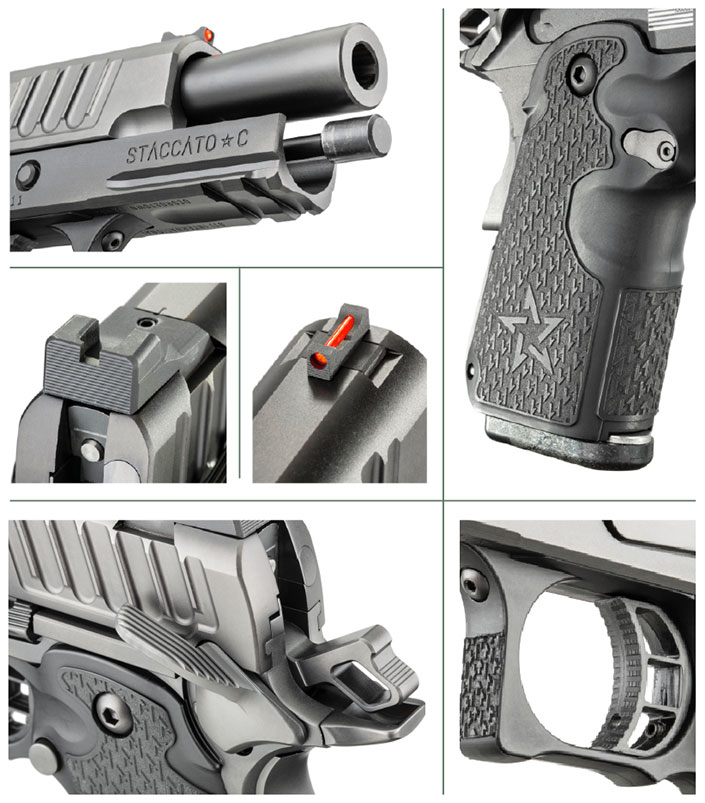
The slide-stop pin on the Staccato has been machined flush with the side of the frame, and the hole in which it resides has been beveled on the right side so as to make it easier for disassembly. The rear of the metal portion of the Staccato frame bears an ambidextrous thumb safety and a beavertail grip safety. The latter of which features a raised palm pad, to ensure complete engagement of the safety when gripped for firing. A nice touch, the frame bears a laser-engraved American flag and Staccato-C on the right side, with a star in the name as well.
An instantly recognizable aspect of STI pistols is the metal frame containing the rails, married to a polymer shell for the magazine housing. The Staccato-C has that, but it differs in a number of ways from STI’s competition-configured pistols with which you may be familiar. First, it is a single-stack frame, and the magazines hold eight rounds of 9 mm. In the early, heady days of everyday carry (EDC), a lot of shooters opted for high-capacity pistols. But they tend to be bulky, and single-stacks are winning back EDC converts.
The polymer frame uses a standard 1911 trigger, the bow of which is also polymer, to make it as light as possible. One trick—learned from competitive shooters modifying the polymer frame—is to sculpt it to make it more ergonomic. STI has done this for you, with the bottom of the trigger guard scalloped and the frame relieved for finger holds. There is one way in which the Staccato-C differs from the full-size STI pistols. It is possible, but not recommended, on the full-size pistols to un-bolt the polymer shell from the metal rails part of the frame. The Staccato is permanently attached, and attempting to, or removing, the polymer shell is bad. Removal will require return to STI for repair, something for which the company will charge. (And rightfully so.) The screw head in question is not for disassembly.
The 1911 trigger is known for being short, clean, crisp and relatively light. Intended as a carry gun, STI builds the Staccato-C with a 4.5-pound trigger pull, which is lighter than your typical striker-fired, polymer-frame high-capacity pistol, but heavier than a target or competition trigger would be. Simply put: It is a useful compromise.
Shooting the STI Staccato-C was pure pleasure. Since the Staccato has STI competition in its DNA, reliable function was expected and confirmed. The felt recoil was quite soft, even with hotter ammunition, as the grip shape helps distribute the paltry oomph of the 9 mm evenly in the hand. Accuracy was also what you would expect from a pistol made by a company that has been building competition guns for a couple of decades.
As with all firearms, you should find what your Staccato likes to shoot most accurately. But with performance that I observed, it shouldn’t be hard to find really accurate ammo for your STI. In the course of chronographing, I found myself on the club’s 100-yard range. I used one of the steel posts of the rifle-gong system as my aiming point and was on the second magazine before I realized I was hitting the 6-inch steel post more than half the time—this pistol is crazy accurate.
With such a short barrel, it would be simple to take the easy out and check accuracy at 15 yards. However, given the accuracy it was demonstrating, I decided not to and tested it at 25 yards instead.
So, you get a compact, accurate, superbly built pistol, in a useful soft case, with two magazines, a kydex holster and a trigger lock. I don’t know how STI could make it any easier a choice. The price may be a bit much for those who want a dirt-cheap emergency tool, but adjusted for inflation, the STI Staccato-C costs less than the added custom work we used to have to have done back in the old days to our 1911s just to get them up to speed. You get all the custom work, plus a compact pistol, and without the long wait. For an EDC pistol with class, performance and ease of carry, it is hard to beat STI’s Staccato-C.
